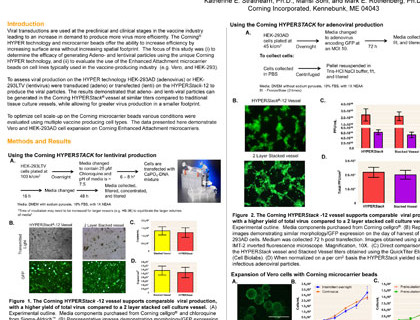
Using the Corning HYPERStack Cell Culture Vessel and the Enhanced Attachment Microcarriers for Scale-Up and Production in the Vaccine Industry
Katherine E. Strathearn, Ph.D., Mansi Soni, and Mark E. Rothenberg, Ph.D. Corning Incorporated
Introduction
Viral transductions are used at the preclinical and clinical stages in the vaccine industry leading to an increase in demand to produce more virus more efficiently. The Corning® HYPER technology and microcarrier beads offer the ability to increase efficiency by increasing surface area without increasing spatial footprint. The focus of this study was (i) to determine the efficacy of generating Adeno- and lentiviral particles using the unique Corning HYPER technology, and (ii) to evaluate the use of the Enhanced Attachment microcarrier beads on cell lines typically used in the vaccine-producing industry (e.g. Vero, and HEK-293).
To assess viral production on the HYPER technology HEK-293AD (adenovirus) or HEK-293LTV (lentivirus) were transduced (adeno) or transfected (lenti) on the HYPERStack-12 to produce the viral particles. The results demonstrated that adeno- and lenti-viral particles can be generated in the Corning HYPERStack® vessel at similar titers compared to traditional tissue culture vessels, while allowing for greater virus production in a smaller footprint.
To optimize cell scale-up on the Corning microcarrier beads various conditions were evaluated using multiple vaccine producing cell types. The data presented here demonstrate Vero and HEK-293AD cell expansion on Corning Enhanced Attachment microcarriers.